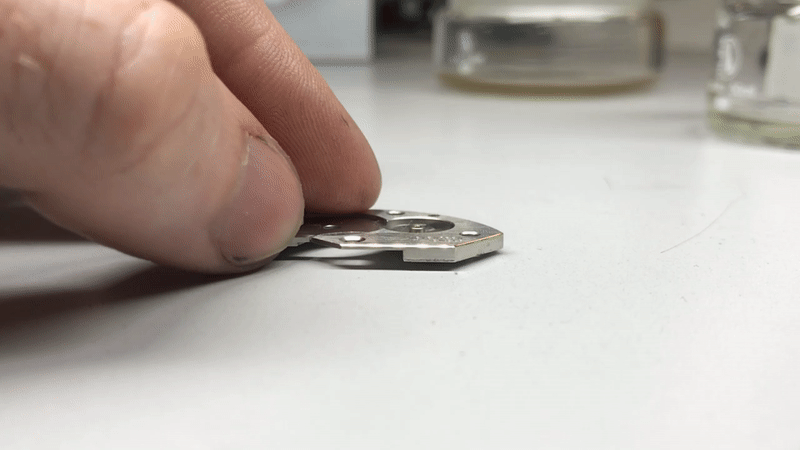Bracelet Refinishing: "Two Tone"

Bracelets need to be refinished just like cases, and present a unique set of challenges to the watchmaker.
Even more than cases, bracelets are always getting scratched and scuffed on desks and tables, especially on the bottom side near the clasp. While the thin metal of the links and clasp mean that buffing is impossible, polishing and abrasive wheels can restore much of the original finish.
Many bracelets have a "two tone" finish—that is, a mixture of polished and brushed finishes on the tops of the links. Unlike cases, which tend to have an angular border between surface finishes, bracelets are all on the same plane, and require a different technique to keep the brushing and polishing from carrying over onto one another.
The first step is to polish the center links to remove as many marks as possible. Since the flappy cotton polishing wheels will reduce crispness on hard borders, this process should be done conservatively. Some deeper scratches might remain, but that's okay; it's more important to retain as much of the links' geometry as possible. Polish will naturally carry over onto the brushed surfaces as well, and that's okay because it is removed in the next few steps.
Since the surface finishes are co-planar, the polished links have to be protected from the abrasive wheels to avoid carry-over.
Flexible cellophane tape is used to mask off the polished middle, allowing the abrasive wheels to get right up to the border. The tape must lie precisely up to the border with the polished and brushed links to work properly. Technically , the line finish can be applied without taping, but the likelihood of marring the polish is substantially increased.
Hard abrasive gray wheels are used to remove scratch damage, but since they’ll tear up the tape, you can’t get the finish right up to the edge. The red flappy wheel is much gentler, and can ride right on the cellophane tape’s border to make a crisp delinition between the finishes. The red wheel is then often used to even out the line finish across the entire bracelet.
The line finish must be straight and even, parallel to the edge of the polished links. Bracelets tend to flare from the clasp to the end links, so it’s a natural tendency to have the line finish follow the flare. This part takes a lot of practice.
The rest of the bracelet is finished with abrasives or polishing, depending on the surface finish desired. I’ll cover all of those steps in a later article!
Watchmaking student at the Lititz Watch Technicum, formerly a radio and TV newswriter in Chicago.









